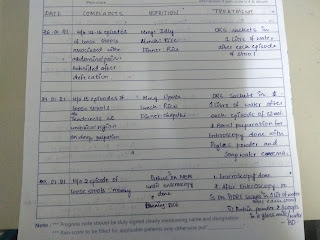Case:1
50 year man, he presented with the complaints of
Frequently walking into objects along with frequent falls since 1.5 years
Drooping of eyelids since 1.5 years
Involuntary movements of hands since 1.5 years
Talking to self since 1.5 years
More here:
Case presentation links:
a). What is the problem representation of this patient and what is the anatomical localization for his current problem based on the clinical findings?
Problem representation:
Problem to be attended:
Seizures
Frequent falls
Ptosis
Self talk
Tremors
Diabetes
Anatomical localization:
Brain
B/l ptosis :there is no loss of frowning which may indicate weakness of levator palbebral superioris
self talk ,may be his problem is in frontal lobe
b) What is the etiology of the current problem and how would you as a member of the treating team arrive at a diagnosis? Please chart out the sequence of events timeline between the manifestations of each of his problems and current outcomes.
Etiology:
Progressive supranuclear palsy: etiology is likely due to accumulation of 'tau' protein in brain
Sequence of events:
Seizures 10 years back
Type 2DM 2 years back
Sudden blurring of vision while riding bike met with RTA -- fracture in left leg ,operated 2 years back
Frequently walking into objects along with frequent falls,droopingof eyelids,I,Involuntarymovements of hands,Talking to self 1.5 years backS
Stoppedalcohol & tobacco consumption 1 year back
Non productive cough 8 months back
Non healing ulcer at surgical site 7 months back
for 1 week - diagnosed as PSP & discharged with SYNDOPA 110 MG & QUETIAPINE
5 days later patient presented to casualty in a state of unresponsiveness with GCS: 3/15 with H/o 2-3 episodes vomiting.
Another 2 episodes of generalized tonic seizures in casualty - treated with levipil
Suddenly his saturations & heart rate dropped with no peripheral pulsations and patient was intubated - CPR done and was resuscitated.
Currently on mechanical ventilator on cpap
c) What is the efficacy of each of the drugs listed in his current treatment plan
Quetiapine:
It is used to treat psychosis in PSP
SYNDOPA: helps parkinson as well as psp according to ncbi
Case:2
Patient was apparently asymptomatic 2 years back then he developed weakness in the right upper and lower limb, loss of speech.
More here:
Case presentation links:
a). What is the problem representation of this patient and what is the anatomical localization for his current problem based on the clinical findings?
Problem presentation:
60 year old male non diabetic & non hypertensive who had a history of CVA 2 years back now presented with c/o SOB,pedal edema,decreased urine output & generalized weakness since 2 months.
Anatomical localization:
Heart - HFrEF secondary to CAD with EF 36 PERCENT
b) What is the etiology of the current problem and how would you as a member of the treating team arrive at a diagnosis? Please chart out the sequence of events timeline between the manifestations of each of his problems and current outcomes.
Etiology:
Coronary artery disease
Ecg shows
1.pathological Q waves from v1 to v6
2.poor R wave progression
suggest a CAD probably involving LAD territory
Sequence of events:
CVA ,2 years back
and
SOB, pedal edema, decreased urine output & generalized weakness since 2months
and
Treated with diuretics(aldosterone antagonist) and beta blockers ,ARB
With salt and Fluid restriction.
Outcome: Symptomatically improved and discharged
c) What is the efficacy of each of the drugs listed in his current treatment plan
Salt and fluid restriction
https://pubmed.ncbi.nlm.nih.gov/23787719/#:~:text=Conclusion%3A%20Individualized%20salt%20and%20fluid,Quality%20of%20life%3B%20Salt%20restriction.
Ninety-seven stable patients in NYHA class II-IV, on optimal medication, with previous signs of fluid retention, treated with either >40 mg (NYHA III-IV) or >80 mg (NYHA II-IV) of furosemide daily were randomized to either individualized salt and fluid restriction or information given by the nurse-led heart failure clinics, e.g. be aware not to drink too much and use salt with caution, and followed for 12 weeks. Fluid was restricted to 1.5 L and salt to 5 g daily, and individualized dietary advice and support was given.
Results After 12 weeks, significantly more patients in the intervention than in the control group improved on the composite endpoint (51% vs. 16%; P < 0.001), mostly owing to improved NYHA class and leg oedema. No negative effects were seen on thirst, appetite, or QoL
Benfomet as thiamine replacement in alcoholic patients
https://www.ncbi.nlm.nih.gov/pmc/articles/PMC4550087/
Case:3
52 year old male , shopkeeper by profession complains of SOB, cough ,decrease sleep and appetite since 10 days and developed severe hyponatremia soon after admission.
Morehere:
Case presentation video:
a) What is the problem representation of this patient and what is the anatomical localization for his current problem based on the clinical findings?
Problem representation:
SOB,
cough,
decreased sleep&appetite
Diabetes
Hypertension
Anemia
Anatomical localization:
Anemia - Nutritional(iron and B12 deficiency)
Hyponatremia -SIADH or dilutional
b) What is the etiology of the current problem and how would you as a member of the treating team arrive at a diagnosis? Please chart out the sequence of events timeline between the manifestations of each of his problems and current outcomes.
Etiology:
Dimorphic anemia may be secondary to ? Nutritional
Hyponatremia secondary to free fluid (dilutional) or poor sugar control (hyperglycemia)
Sequence of events:
Type 2 DM & HTN since 1 year
And
SOB,Cough
Decreased sleep and appetite (10 days)Admitted
Diagnosed with Dyselectrolytemia (hyponatremia)
Treated conservatively & discharged
c) What is the efficacy of each of the drugs listed in his current treatment plan especially for his hyponatremia? What is the efficacy of Vaptans over placebo? Can one give both 3% sodium as well as vaptan to the same patient?
Can be given if it is SIADH tolvaptan can be given.
3percent NS may not be necessary because sodium levels here are 131 near to normal lower limit,no need of correction acutely.
4) Please mention your individual learning experience from this month
- A case of portal Htn with refractory ascitis with rt side pleural effusion ? Hepatic hydrothorax,ruling Budd chiari syndrome.
- A case of Broncho-alveolar carcinoma--Lung biopsy - showed organizing pneumonia
- A case of Celiac disease treated with gluten free diet diagnosed by biopsy resultswith superimposed giardiasis
- A case of primary PAH
- A case of ASD (?ostium secundum)
- A case of severe PAH secondary to PTB--lung fibrosis--cor pulmonale about cardiogenic shock in this case.
- A case of bronchiectasis.
- About prerequisites for renal transplantation.
- Cases HFpEf and HFrEF simultaneously
- Case of alcoholic liver cirrhosis with alcoholic polyneuropathy.
- Case of Viral encephalitis with 3rd nerve palsy
- Case of gestational trophoblastic neoplasia



Comments
Post a Comment